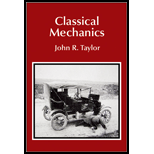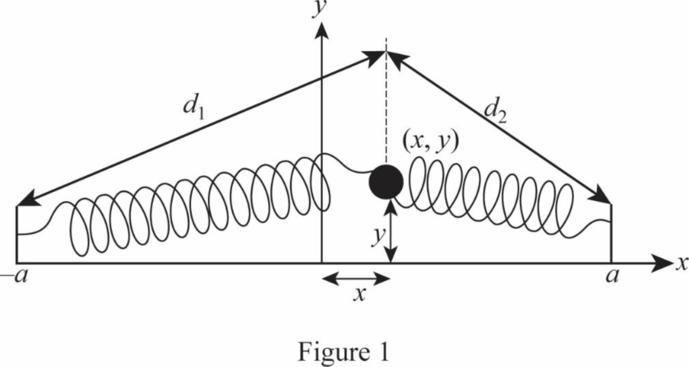
Show that when the mass moves to a position
Answer to Problem 5.18P
Therefore, it is proved that when the mass moves to a position
Explanation of Solution
Write the expression for the potential energy of the spring
Here,

The above figure represents the given situation.
From figure, the spring on the left hand side is stretched and the spring on the right hand side is compressed.
Spring on the left hand side [stretched]:
The total length of the spring,
The stretched length of the spring from its equilibrium length
Spring on the right hand side [compressed]:
The total length of the spring,
The compressed length of the spring from its equilibrium length
The potential energy stored in the stretched spring on left is
Substitute
The potential energy stored in the compressed spring on right is
Substitute
The total potential energy of the system,
Substitute equation (II) and (III) in the above equation to solve for
Write the Taylor expansion for
Applying Taylor expansion for the terms
Given that
Solving further,
Neglecting the higher power terms and solving
Here, the potential energy is shifted by the constant
The potential energy of the system is
In the above equation,
Therefore, it is proved that when the mass moves to a position
When the mass is at the origin,
Substitute
The potential energy of the two-spring-mass is zero at the origin. Thus, the system is in unstable equilibrium state at origin.
Write the Hessian
Solve for
Solve for
Solve for
Solve for
Substitute
Substitute
In the above matrix, when
Conclusion:
Therefore, it is proved that when the mass moves to a position
Want to see more full solutions like this?
Chapter 5 Solutions
Classical Mechanics
 College PhysicsPhysicsISBN:9781305952300Author:Raymond A. Serway, Chris VuillePublisher:Cengage Learning
College PhysicsPhysicsISBN:9781305952300Author:Raymond A. Serway, Chris VuillePublisher:Cengage Learning University Physics (14th Edition)PhysicsISBN:9780133969290Author:Hugh D. Young, Roger A. FreedmanPublisher:PEARSON
University Physics (14th Edition)PhysicsISBN:9780133969290Author:Hugh D. Young, Roger A. FreedmanPublisher:PEARSON Introduction To Quantum MechanicsPhysicsISBN:9781107189638Author:Griffiths, David J., Schroeter, Darrell F.Publisher:Cambridge University Press
Introduction To Quantum MechanicsPhysicsISBN:9781107189638Author:Griffiths, David J., Schroeter, Darrell F.Publisher:Cambridge University Press Physics for Scientists and EngineersPhysicsISBN:9781337553278Author:Raymond A. Serway, John W. JewettPublisher:Cengage Learning
Physics for Scientists and EngineersPhysicsISBN:9781337553278Author:Raymond A. Serway, John W. JewettPublisher:Cengage Learning Lecture- Tutorials for Introductory AstronomyPhysicsISBN:9780321820464Author:Edward E. Prather, Tim P. Slater, Jeff P. Adams, Gina BrissendenPublisher:Addison-Wesley
Lecture- Tutorials for Introductory AstronomyPhysicsISBN:9780321820464Author:Edward E. Prather, Tim P. Slater, Jeff P. Adams, Gina BrissendenPublisher:Addison-Wesley College Physics: A Strategic Approach (4th Editio...PhysicsISBN:9780134609034Author:Randall D. Knight (Professor Emeritus), Brian Jones, Stuart FieldPublisher:PEARSON
College Physics: A Strategic Approach (4th Editio...PhysicsISBN:9780134609034Author:Randall D. Knight (Professor Emeritus), Brian Jones, Stuart FieldPublisher:PEARSON





